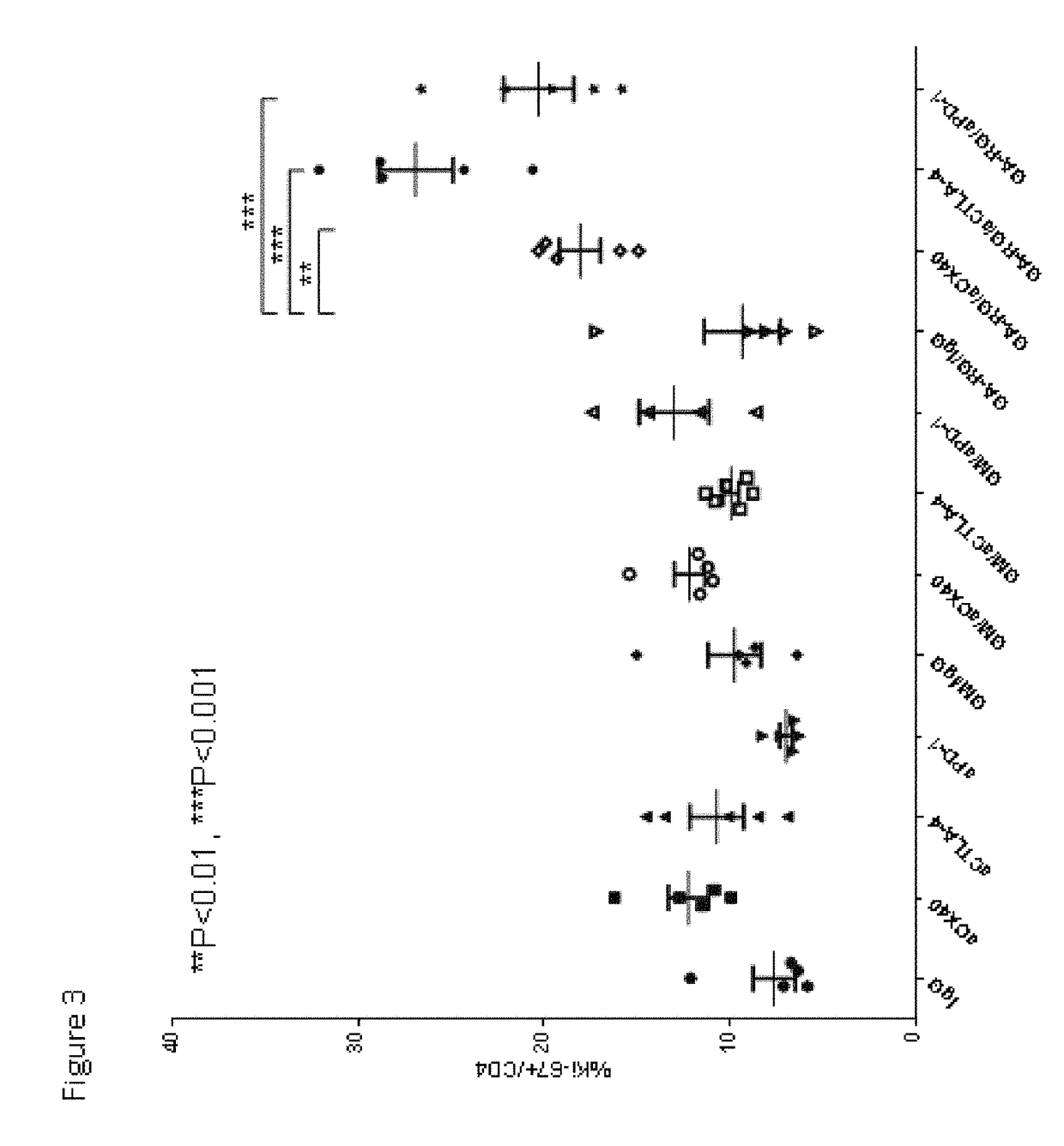Method for enhancing specific immunotherapies in cancer treatment
a specific immunotherapy and cancer treatment technology, applied in the direction of immunological disorders, drug compositions, antibody medical ingredients, etc., can solve the problems of partially successful and obstacles in therapeutic interventions, and achieve the effect of increasing the efficacy of immunotherapy and boosting immune function
- Summary
- Abstract
- Description
- Claims
- Application Information
AI Technical Summary
Benefits of technology
Problems solved by technology
Method used
Image
Examples
example 1
nt of Immune and Prostate Tumor Response Following Co-Treatment with Anti-CTLA-4, Anti-OX40, or Anti-PD-1 in Combination with GA-RG and GM
[0146]In this example, experiments were performed in a syngeneic model of mouse cancer. The tumor cells used were the TRAMP-C1 cell line which was derived from a mouse prostate cancer. To derive these cells, the SV40 large T antigen was expressed in a transgenic mouse with a prostate specific gene promoter, thereby expressing SV40 large T specifically in prostate tissue. The TRAMP-C1 cell line was derived from resultant prostate tumors; importantly, the cell line does not express SV40 large T-antigen. For the tumor model, TRAMP-C1 cells (1×10sup6 cells) were inoculated into normal C57BL / 6 mice via subcutaneous injection.
[0147]Following inoculation with TRAMP-C1 cells, groups of mice were treated via intra-peritoneal injection with either IgG (as a control, on days 4, 6 and 8 days after inoculation), or anti-CTLA-4 (200 micrograms on days 4, 6 and ...
example 2
nt of Immune and Prostate Tumor Response Following Co-Treatment with Anti-CTLA4 or Anti-OX40 in Combination with GA-RG
[0156]In this example, experiments were performed in a syngeneic model of mouse cancer. The tumor cells used were the TRAMP-C1 cell line which was derived from a mouse prostate cancer, as described in Example 1.
[0157]The example includes six treatment groups of tumor inoculated mice with two groups in each of the following: IgG treated control mice with and without GA-RG (1.2 mg / dose) on days 4, 8, 11 and 15 after inoculation; mice treated with aOX40 (250 microgram or mcg) with and without GA-RG (1.2 mg / dose) on days 4, 8, 11 and 15 after inoculation; and mice treated with aCTLA4 (200 mcg) on days 4, 6, 8, 11, 13, and 15 after inoculation with and without GA-RG (1.2 mg / dose) on days 4, 8, 11 and 15 after inoculation.
[0158]FIG. 5 shows results of these treatments on tumor size at various times after inoculation. While treatment with aOX40, aCTLA4, and GA-RG alone had ...
example 3
nt of Immune and Breast Tumor Response Following Co-Treatment with Anti-CTLA4 or Anti-OX40 in Combination with GA-RG
[0161]In this example, experiments were performed in a syngeneic model of mouse breast cancer. The tumor cells used were the 4T1 which is a syngeneic breast cancer cell line derived from a spontaneously arising BALB / c mammary tumor. When introduced orthotopically, the 4T1 line grows rapidly at the primary site and forms metastases in lungs, liver, bone and brain over a period of 3-6 weeks. When introduced via the tail vein or arterially, metastases are apparent in these same organs after 1-2 weeks. The rapid and efficient metastasis to organs affected in human breast cancer makes the 4T1 model an excellent mouse model for the study of metastatic progression of breast cancer in humans. Because the model is syngeneic in BALB / c mice, it can be used to study the role of the immune system in tumor growth and metastasis. For the tumor model in these experiments, 4T1 cells (5...
PUM
| Property | Measurement | Unit |
|---|---|---|
| molecular weight | aaaaa | aaaaa |
| average molecular weight | aaaaa | aaaaa |
| molecular weight | aaaaa | aaaaa |
Abstract
Description
Claims
Application Information
 Login to View More
Login to View More - R&D
- Intellectual Property
- Life Sciences
- Materials
- Tech Scout
- Unparalleled Data Quality
- Higher Quality Content
- 60% Fewer Hallucinations
Browse by: Latest US Patents, China's latest patents, Technical Efficacy Thesaurus, Application Domain, Technology Topic, Popular Technical Reports.
© 2025 PatSnap. All rights reserved.Legal|Privacy policy|Modern Slavery Act Transparency Statement|Sitemap|About US| Contact US: help@patsnap.com



